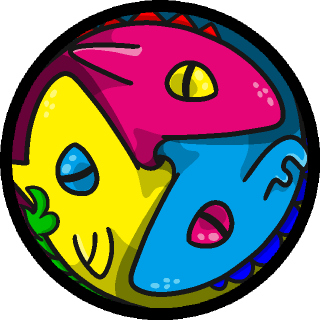Shadow Wyvern
"When I finally gathered the courage to go check out the noise, I crept out with my torch and shone it on what I thought was a pile of junk in the corner, but instead I saw two huge gleaming eyes staring right back at me! I practically jumped out of my skin!"
Shadow wyverns are flying carnivorous reptiles found in The Shadow, a dim oasis formed by a colossal floating island hovering over the Great Desert. The wyverns adapted quickly to sapient habitation and are comfortable with urban habitats.
Considered a pest by many, shadow wyverns are bold and stubborn. They are extremely food motivated and have an excellent sense of smell. If there is a weakness in someone's food storage, the shadow wyverns will find it. Especially brave individuals may even bully people into surrendering their lunch!
Shadow wyverns are nocturnal, and spend the day on the top of the Shadow's floating islands. There, they can warm themselves in the sun and keep safe from people and predators below. When night falls, they descend to the ground to search for food, mates, and mischief.
Basic Information
Anatomy
Shadow wyverns are medium sized. They have large, round eyes, sharp talons, and needle-like teeth. Their scales are matte black, navy, or sometimes very dark red.
They are quadrupedal; their forelimbs double as both wings and legs. They have four fingers on each hand. Their outermost finger is extremely long, and has a membrane stretching from its tip to the base of the wyvern's tail.
The shadow wyvern is known for having above-average dexterity in its other three fingers. They are able to climb, dig, manipulate small objects, and even solve simple puzzles with their hands.
Genetics and Reproduction
Shadow wyverns can mate at any time of year. Females emit pheromones when they are fertile, which males follow the scent of. If the female finds the male acceptable, they will mate. After mating, the pair will separate and likely not interact again until the next mating season.
Soon after mating, the female flies to the underside of a floating island. There, they nest in crags of the rock. They often have vicious disputes with other wyverns over favorite nesting spots.
A typical clutch has 6 to 12 eggs. Females guard the eggs during their gestation. They moderate the eggs' temperature and use their Glow to warm them if they get too cold. The eggs hatch after 40 to 60 days. Once the first egg begins hatching, the mother stops guarding the clutch, leaving the babies on their own for the rest of their lives.
Baby shadow wyverns must learn to fly immediately upon birth by jumping from their nests. If they don't, they will starve to death or be eaten--sometimes by their own kind.
Dietary Needs and Habits
Shadow wyverns are carnivores. They eat small animals, such as lizards, birds, or tatzels, as well as any food they can scavenge. While they can digest grains and some vegetables, they vastly prefer meat.
Shadow wyverns know no such thing as being "full". They are always on the hunt for the next snack.
Additional Information
Average Intelligence
Despite how resourceful a shadow wyvern can be, they are far from the most intelligent of reptiles. They do not store food for later, as their memory isn't sharp enough to recall where they left it. They have poor foresight, and often get themselves into deeper trouble than they intended.
They do not socialize with others of their kind except during mating season. They regard every wyvern as a stranger, and don't seem to recognize specific individuals for longer than a day or two.
If a shadow wyvern sees no immediate solution to a problem, they will not spend much time working at it. It doesn't take long for them to get frustrated and give up.
They can be easily stumped by tatzels, which make up for their tiny size with far superior intelligence. Tatzels often work together to steal food from shadow wyverns and use many clever hijinks to escape being eaten by them.
Perception and Sensory Capabilities
A shadow wyvern's huge eyes allow it to see perfectly in very little light. They cannot discern colors very well and can be confused by complicated patterns or visual illusions. They are farsighted, and might have trouble focusing on things that are too close to their face.
They also have an impressive sense of smell and decent hearing, which they use to track down prey and avoid danger. They use many vocalizations to communicate with other creatures, including screeching, hissing, and trilling.







"They do not store food for later, as their memory isn't sharp enough to recall where they left it." BABIES. Adorable
The lights in their head are on but nobody is home